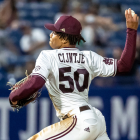
As Major League Baseball continues to suffocate under the weight of an owner lockout that's put almost all of the sport on hold, it's perhaps instructive to look back at the labor kerfuffle that preceded the current one.
We speak not of the last labor stoppage -- the 1994-95 players' strike -- but rather of the fraught negotiations leading up to the 2020 season. That season, greatly complicated by the COVID-19 global pandemic, wound up spanning just 60 regular-season games with an expanded postseason and no fans in attendance until late in the playoffs. Arriving at that structure, however, wasn't easy, and we'll soon be reminded didn't signify a successful negotiation.
So as the current owner-initiated work stoppage continues into the uncertain future, let's take a moment to ponder how those 2020 negotiations may have informed the current talks.
The absence of a work stoppage does not equal "labor peace"
During the run-up to the lockout and in the immediate appraisals of it, you no doubt heard that a long run of "labor peace" has ended given that this is, to repeat, the first work stoppage in 26 years. While that's indeed an unprecedented run in the history of MLB-MLBPA relations, don't mistake it for peace. Even before the owners voted unanimously to lock out the players, relations between the two sides had been fraught and at times hostile. What happened before the 2020 season is an acute reminder of that fact.
You'll recall that the players early on in the process agreed to prorate their salaries downward based on the number of games played during the 2020 season. Since we wound up with a 60-game slate, players made just 37 percent of their full-season salaries for 2020. When much later it came to seem increasingly likely that fans would not be permitted to attend games (a thoroughly predictable turn of events), owners insisted that the matter of player salary was still open for negotiation. Players -- pointing to that March 2020 agreement -- considered the matter settled. Ultimately, that turned out to be the case, but not until a great deal of time was frittered away.
While at least a few team owners wanted to run out the clock and not play a 2020 season, commissioner Rob Manfred in late June finally implemented a season structure by fiat, as he was allowed to do by that same March agreement in which players agreed to prorate their salaries. That's a key detail because owners and the union were not able to forge an agreement on the 2020 season. Instead, Manfred handed it down. Stated another way, the last time these two sides got together to negotiate a working agreement, they weren't able to get it done. As part of the fallout, the union filed a $500 million grievance against MLB in which it alleged the league did not seek to play the longest economically feasible season possible. That grievance is still pending at this writing.
As well, we almost had a stoppage the last time the CBA expired. Said CBA was set to expire on Dec. 1, 2016, and players and owners didn't reach a preliminary agreement until the day before that deadline. Very likely, we were within hours of a winter lockout. This time, of course, that lockout – the first offseason lockout in MLB history – came to pass.
Whatever this was, it wasn't peace. And now that long cold war has turned hot.
Owners will try to hide revenues even from the union
With vanishingly few exceptions, MLB teams are privately held, and that means they don't have to release financial statements. That, in turn, means they're free to lie about their finances, and that's something team owners have done for decades. Those lies are typically of the calculated variety designed to enlist public opinion in owners' ongoing efforts to limit player salaries. Far too often, we go along with it.
In this space when addressing these matters, we're fond of dragging an old Paul Beeston quote howling from the vaults. Here's what the former Blue Jays president and highly placed MLB exec once said:
"Anyone who quotes profits of a baseball club is missing the point. Under generally accepted accounting principles, I can turn a $4 million profit into a $2 million loss, and I can get every national accounting firm to agree with me."
So it goes, and that's why you should never believe any public statements about league or team finances. The 2020 negotiations, however, taught us – or at least reminded us – that it's not just fans and media who get misled about the money. It's also the union.
There's a broader discussion about the efforts of the league to wall off certain revenue streams as having nothing to do with MLB players or the games themselves, even though all the money traces back to those very entities. These are things like real estate ventures surrounding the (almost always) publicly funded ballparks, equity stakes in regional sports networks instead of market-rate rights fees, and even the sale of BAMTech to Disney. In the 2020 negotiations, however, MLB couldn't be bothered to show its work even while claiming that playing a season without fans would cripple the business. As Ken Rosenthal of The Athletic reported at the time, an attorney for the union characterized MLB's financial disclosures during negotiations as "so heavily redacted as to be essentially meaningless."
MLB has long for reasons of public persuasion cried poor in the media, but calling for concessions from its negotiating counterpart while failing to prove the necessity of them constitutes another tier of audacity. Don't be shocked if it's part of the owner playbook from now on.
Owners are prone to making non-serious offers during bargaining
Already during the lockout, we've seen the ownership side propose a salary floor -- an idea with merit in and of itself -- but then make that reasonable-seeming change untenable by making structural changes elsewhere than in total lop of tens of millions of dollars from the players' already shrinking share of revenues. Invariably, the league will leak the general scope of such offers while hoping no one bothers to run the numbers. This was very much the case during the 2020 negotiations, as owners time and again offered up what was in essence the same rejected proposal costumed in various ways. Last year, the goal may have been time-wasting in an effort to run out the clock and eliminate the possibility of playing a season. This time around, the goal of non-serious proposals maybe be similar: to drag things out until players start missing game checks. Possibly this is exhibit A on this front:
"One of the most disappointing about the trip to Dallas was that the owners didn't make one economic proposal the entire time we were there." -Happ #Cubs @670TheScore
— The Bernstein & Rahimi Show (@BernsteinRahimi) December 9, 2021
The deliberate pace is perhaps not a sign of anything more than a wish to be deliberate.
Players are unified
Speaking of all that, coming into 2020 we had in the majors multiple generations of players who had no direct knowledge of a major labor conflagration. While that's good on one level, it makes solidarity a challenge. The 2020 negotiations and the way owners handled them, however, changed that, and we're left with a union that's operating more in lockstep than it has in living memory.
That's essential to the union's aims during the current CBA negotiations because of the sharp class divisions within their membership. Younger, pre-arbitration players are taking up more roster spots than ever and providing more on-field value than ever. They're also grossly underpaid, and they're the ones with the most to gain (or lose) with the next CBA. It's not hard to imagine an upper class of veteran players -- those with nine-figure contracts in force -- that's disinclined to fight long and hard for a demographic not their own. Thanks to the galvanizing struggles of 2020, however, that's not the case, at least not yet. Take, for instance, this declaration by no less a figure than Max Scherzer:
"Unless this CBA completely addresses the competition (issues) and younger players getting paid, that's the only way I'm going to put my name on it."
If Scherzer -- he of the $221 million in career earnings and new $130 million contract with the Mets -- is ready to go to the mat for the underclass of players, then it's a positive sign for the union.


















